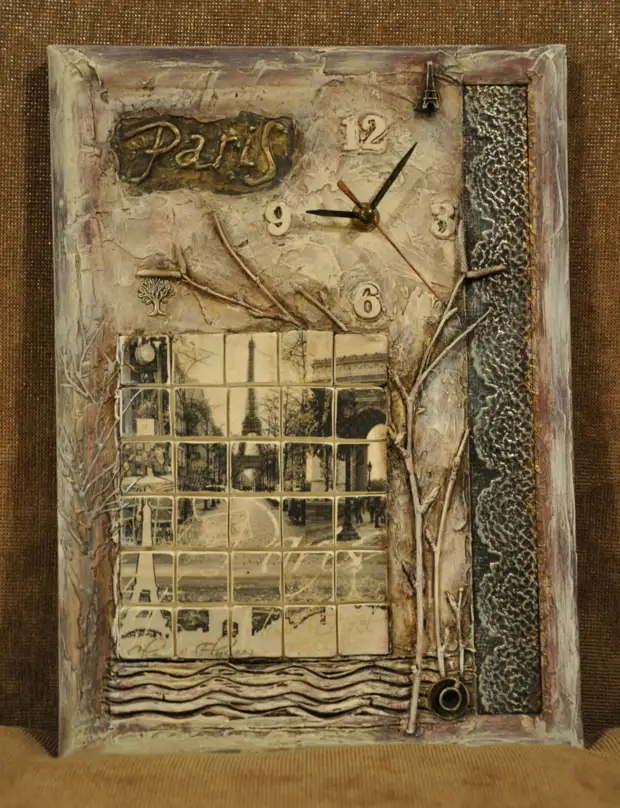
"Autumn. Morning. Paris ..."
Necessary materials:
1. Billet (tree, plywood, organic, MDF, canvas on cardboard ...) Punk,
or blank for hours, or maybe one side of the journal, or
The lid of the box ... size is about 25 to 35 (to be where to turn around).
2. Mass for modeling (selfless). Anyone. White.
3. Lace (or thin twine, or thick thread)
4. Food foil
5. Napkin, corresponding to the topic !!!
6. Plotlevka
7. Any Khabiores-Prickindors on the topic: Shells, stones, glands, rags, branches, wood, buttons, ...
8. Glue, varnish, paints, patina
Stage 1.
1. Mass for the modeling rolling 0.5 cm thick. Cutting carefully
Plast on smooth squares (and maybe on uneven, it all depends on
Figure on the selected napkin)
2. Without waiting for drying, we glue the napkin on the resulting mosaic
3. Despise all together and lachm
4. We cut the napkin layer and eat the sidewall sideways
(you can round the edges and fill out, but look at
Picture !!!) We glue with a minimum gap.
Before we turn to the next stage, I would like to notify you
About the least ... We will make a collage (more precisely the Assembly).
Therefore, it will be necessary to know the basic rules for composite construction.
In the meantime, you can search for a place for your mosaic based on. This element
It will most likely visually the most difficult. Therefore, we have it in
The bottom of the base.
Glue mosaicinks with a small gap. Not to the edge of the base, of course.
Now a little about the composition (hereinafter K). I will try in my words without ability (although with everything is very difficult ...)
The definitions of the sea ... I would call it like this: to - this is the combination of elements of a random in a natural whole.
We will make the easiest view to - frontal, plane. There is also a bulk and spatial ...
The basis of any composite construction is the idea that will allow everything to combine.
In order for our elements to not look disparate and random, you need to know signs to:
1. I do not want to add nor down, nor move any element.
2. There is a desire to consider and study to and receive aesthetic pleasure from this.
3. Elements should look intelligently, and for this they should be from 5 to
9 maximum!; They must be compact, so that the connection is not lost
between them (the more they will remove them from each other, the weaker
communication); It should be felt a natural adjoining of elements of each other
to a friend (as a sectional sofa: at least slim him, even throw it, - you see that
Sections are sharpened to each other)
4. Must be to be dominant - the main element standing out against the background of the rest and first of all attracting our attention.
5. The visual equilibrium should be felt. Here
it requires, probably clarification ... Do not put larger and dark
The objects are above small and light. Do not overload one part
Plane, leaving the second part free. Do not place all the texture with
One side, leaving the second glossy, etc. ....
What else is important ...
- scale. Elements should be large-scale each other! And to the whole!
- proportionality, i.e.
Harmonious combination and proportionality of elements. Harmonious proportions
Found a long time ago, there is a "golden cross section" ... you can search for them
Calculate ... But in the selection of proportions and the authorship is felt. So know
They need them, but to use without fanaticism!
There is also such a concept as an emphasis - this is a raisin K. Accents
just like the dominant, sharply contrast with the surrounding background, but
these are much weaker and do not attract attention directly to themselves, but
contribute to a variety.
Stage 2.
Imitation of chakeanka
1. Create a volume ornament of the future "chasing". It can be volumetric
lace; pattern made by bulk contour; twist
or thick thread; Sometimes there are beautiful volumetric candy boxes
Plastic liners ... maybe you still think up. Find a place for
This thing and glipe on the glue type of moment.
2. After drying, we stick the bulk element of the food foil,
Carefully and gently pushing all the hollows. I think better foil
Plant on varnish.
3. Patinate the resulting "chasing". If the patches are no special, you can
Use the usual acrylic paint with a dried retarder. Shave
put the entire surface completely, and then erase the paint on
bulges. Only without fanaticism! did not satisfy the result -
Repeat.
Stage 3.
Finishing (traditional creative)
Now popular has become the technique of "Terra". This is a floristic technique, and we are the idea of the idea ... Muffle in the putty all that they prepared on the topic. Just do not forget about the composition !!! Under the twin hitch and edges of the foil.
Author Lyolik Veronica
A source
